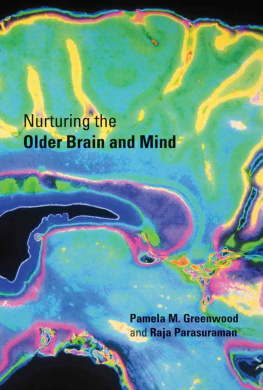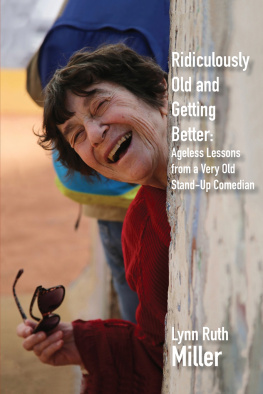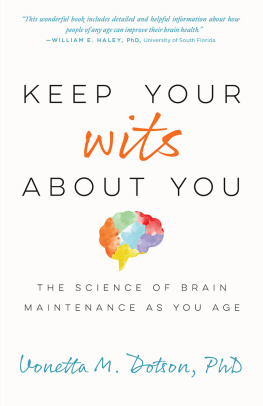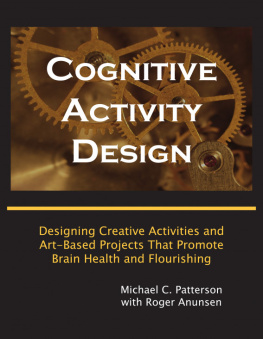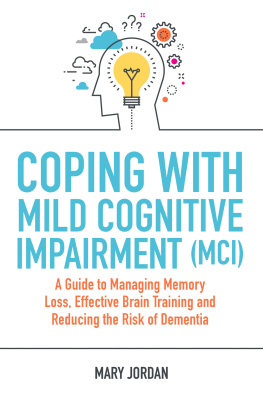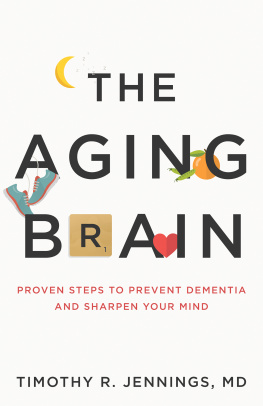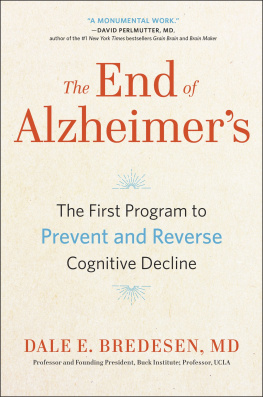Nurturing the Older Brain and Mind
Nurturing the Older Brain and Mind
Pamela M. Greenwood and Raja Parasuraman
The MIT Press
Cambridge, Massachusetts
London, England
2012 Massachusetts Institute of Technology
All rights reserved. No part of this book may be reproduced in any form by any electronic or mechanical means (including photocopying, recording, or information storage and retrieval) without permission in writing from the publisher.
Excerpt from Provide, Provide (from The Poetry of Robert Frost, ed. Edward Connery Lathem, 1969 Henry Holt and Company, 1936 Robert Frost, 1964 Lesley Frost Ballantine) reprinted by arrangement with Henry Holt and Company, LLC.
Excerpt from In View of the Fact (from A. R. Ammons, Bosh and Flapdoodle, 2005 John R. Ammons) used by permission of W. W. Norton & Company, Inc.
For information about special quantity discounts, please email .
Library of Congress Cataloging-in-Publication Data
Greenwood, Pamela M., 1947
Nurturing the older brain and mind / Pamela M. Greenwood and Raja Parasuraman.
p. cm.
Includes bibliographical references and index.
ISBN 978-0-262-01714-5 (hardcover : alk. paper)
ISBN 978-0-262-30055-1 (retail e-book)
I. Parasuraman, R. II. Title.
[DNLM: 1. Brainphysiology. 2. Aged. 3. Agingphysiology. 4. Cognition physiology. 5. Neuronal plasticity. WL 300]
LC classification not assigned
612.8'20846dc23
2011030565
10 9 8 7 6 5 4 3 2 1
d_r1
Man makes himself through enlightened choices that enhance his humanness.
Rene Dubos, So Human an Animal
Preface
The population of older adults continues to expand, both in the United States and worldwide. Whereas physical abilities clearly decline as we age, the most recent scientific research does not support the long-held view that our minds must also inevitably grow dim. The popular notion of inexorable, progressive cognitive decline raises the prospect of nations increasingly burdened by their growing numbers of older citizens. Certainly, relative to the young, older people, on average, perform at a lower level on many (but not all) perceptual, cognitive, and motor tasks. But with the exception of disorders affecting older adults, such as Alzheimers disease, cognitive decline in healthy old age is neither universal nor inevitable.
Some older adults maintain their level of cognitive functioning even in very old age, and a few even outperform their younger counterparts. Is there something special about these individuals? Yes and no. No, because various experiential and lifestyle factorsincluding education (both early and late in life), exercise, diet and nutrition, opportunities for new learning, and, more controversially, use of estrogen or cognition-enhancing drugsmay contribute to maintenance of cognitive function in late life. Yes, since certain genetic factors may help some individuals to avoid the extreme effects of cognitive aging or of dementing disease. But, as we document in this book, irrespective of genes, all older individuals can benefit cognitively from exposure to these experiences at any stage of life.
We begin the book with a reappraisal of the scientific evidence on aging, cognitive function, and the brain. Across a range of speciesrats, monkeys, humanswe show that a substantial subset of older individuals do not succumb to cognitive decline and do not show age-related neuronal changes. Moreover, the neural substrate of cognitive aging has not been identified. The best-documented brain change over the course of healthy agingregional brain shrinkageis not reliably linked to cognitive decline. The effects of aging on biophysical properties of neurons are selective and subtle, seen only in specific brain regions and cell types. Nor do age-related synaptic changes necessarily lead to corresponding changes in neuronal transmission and thereby to cognitive decline. Finally, age-related synaptic changes are plastic and reversible.
We describe the scientific evidence supporting these statements regarding cognitive and brain aging in chapters 13. In .
Complementary to the approach of adapting the older individual is the approach of adapting the environment (e.g., at work and at the home) to support optimal cognitive functioning in older adults. That approachbased on principles drawn from human factors and from cognitive engineeringinvolves changing the environment and changing the interfaces between people and the devices and systems they use. It is described in chapter 11. Cognitive engineering seeks to design systems that take human capabilities into account while minimizing the effects of the physical and cognitive limitations of older adults. A number of demonstration projects have been undertaken, most of them aimed at helping older people to age in placethat is, to remain in their own homes despite physical health problems. One example is the use of computerized virtual assistants.
Genetic factors may temper the influence on cognitive aging of the various experiential and environmental factors we discuss in the earlier chapters. Advances in molecular genetics have increased our knowledge of how genes contribute to individual differences in various cognitive functions, of the brain networks that control these functions, and of the neurotransmitters that innervate these networks. As gene-environment interactions become better understood, we may be in a better position to understand both the potential and the limits of efforts to promote cognitive vitality in older individuals. We discuss these issues in .
In we summarize several ways in which the effects of cognitive aging can be ameliorated. These methods can make a measurable difference to cognitive and brain integrity late in life. Yet it is prudent to consider not only what can be done but also what should be done. Dietary restriction is not for everybody and may pose risks that arent known yet. As to the use of estrogen by peri- or post-menopausal women, the jury is still out. The use of cognition-enhancing drugs raises ethical issues and concerns about addiction. The use of computer-based cognitive assistants in the home raises issues of complacency, dependency, and the possibility of social neglect. But many of the other ameliorative factors we discuss in this bookeducational experiences, physical exercise, diet and nutrition, opportunities for new learningpose minimal risks to older adults.
The first wave of the post-World War II baby boomers is now reaching the point at which age-related cognitive decline can be detected, on the average. But nothing forces any individual to follow the mean course. In the past 20 years, scientific research on cognitive and brain aging has given us a sound knowledge base that we can exploit to point to how older adults can lead rich and cognitively vital lives.
Preparation of this book was aided by grants we received for our research from the National Institute on Aging, the Virginia Council on Aging, and the Mason-INOVA Life Sciences Research Collaboration Fund. The interpretations of data and the opinions we offer in this book are our own and should not be considered to reflect the views of those agencies. We also thank our colleagues at George Mason University and the many post-doctoral fellows, graduate, and undergraduate students who have worked with us for fruitful discussions on the effects of experiential factors on brain plasticity and cognitive aging.
1 Global Aging and Cognitive Functioning
... Make the whole stock exchange your own!
If need be occupy a throne,
Where nobody can call you crone...
No memory of having starred
Atones for later disregard,
Or keeps the end from being hard.
Better to go down dignified
With boughten friendship at your side
Than none at all. Provide, provide!
Next page
